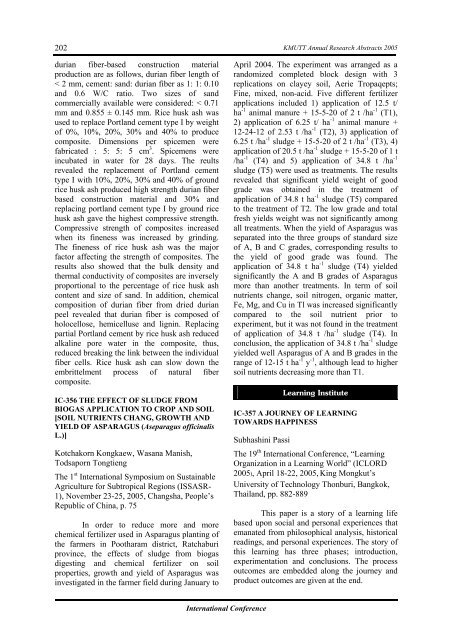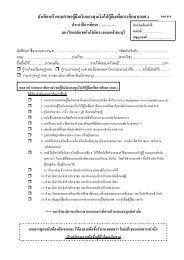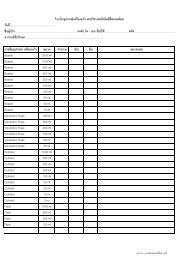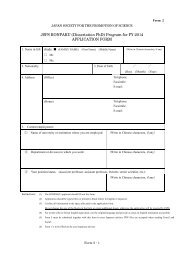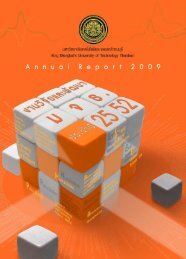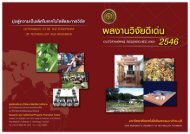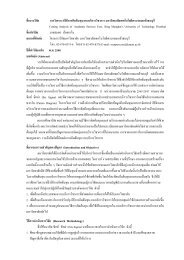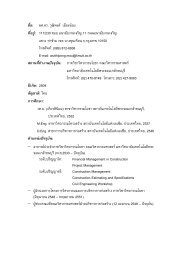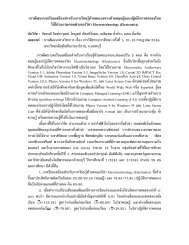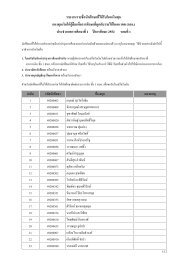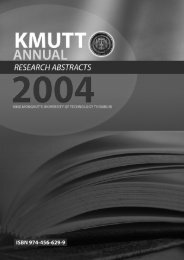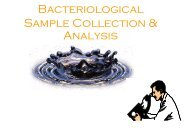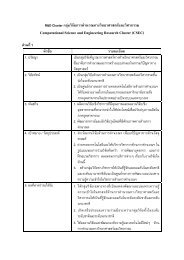Create successful ePaper yourself
Turn your PDF publications into a flip-book with our unique Google optimized e-Paper software.
202<br />
durian fiber-based construction material<br />
production are as follows, durian fiber length of<br />
< 2 mm, cement: sand: durian fiber as 1: 1: 0.10<br />
and 0.6 W/C ratio. Two sizes of sand<br />
commercially available were considered: < 0.71<br />
mm and 0.855 ± 0.145 mm. Rice husk ash was<br />
used to replace Portland cement type I by weight<br />
of 0%, 10%, 20%, 30% and 40% to produce<br />
composite. Dimensions per spicemen were<br />
fabricated : 5: 5: 5 cm 3 . Spicemens were<br />
incubated in water for 28 days. The reults<br />
revealed the replacement of Portland cement<br />
type I with 10%, 20%, 30% and 40% of ground<br />
rice husk ash produced high strength durian fiber<br />
based construction material and 30% and<br />
replacing portland cement type I by ground rice<br />
husk ash gave the highest compressive strength.<br />
Compressive strength of composites increased<br />
when its fineness was increased by grinding.<br />
The fineness of rice husk ash was the major<br />
factor affecting the strength of composites. The<br />
results also showed that the bulk density and<br />
thermal conductivity of composites are inversely<br />
proportional to the percentage of rice husk ash<br />
content and size of sand. In addition, chemical<br />
composition of durian fiber from dried durian<br />
peel revealed that durian fiber is composed of<br />
holocellose, hemicelluse and lignin. Replacing<br />
partial Portland cement by rice husk ash reduced<br />
alkaline pore water in the composite, thus,<br />
reduced breaking the link between the individual<br />
fiber cells. Rice husk ash can slow down the<br />
embrittelment process of natural fiber<br />
composite.<br />
IC-356 THE EFFECT OF SLUDGE FROM<br />
BIOGAS APPLICATION TO CROP AND SOIL<br />
[SOIL NUTRIENTS CHANG, GROWTH AND<br />
YIELD OF ASPARAGUS (Aseparagus officinalis<br />
L.)]<br />
Kotchakorn Kongkaew, Wasana Manish,<br />
Todsaporn Tongtieng<br />
The 1 st International Symposium on Sustainable<br />
Agriculture for Subtropical Regions (ISSASR-<br />
1), November 23-25, 2005, Changsha, People’s<br />
Republic of China, p. 75<br />
In order to reduce more and more<br />
chemical fertilizer used in Asparagus planting of<br />
the farmers in Pootharam district, Ratchaburi<br />
province, the effects of sludge from biogas<br />
digesting and chemical fertilizer on soil<br />
properties, growth and yield of Asparagus was<br />
investigated in the farmer field during January to<br />
KMUTT Annual Research Abstracts 2005<br />
April 2004. The experiment was arranged as a<br />
randomized completed block design with 3<br />
replications on clayey soil, Aerie Tropaqepts;<br />
Fine, mixed, non-acid. Five different fertilizer<br />
applications included 1) application of 12.5 t/<br />
ha -1 animal manure + 15-5-20 of 2 t /ha -1 (T1),<br />
2) application of 6.25 t/ ha -1 animal manure +<br />
12-24-12 of 2.53 t /ha -1 (T2), 3) application of<br />
6.25 t /ha -1 sludge + 15-5-20 of 2 t /ha -1 (T3), 4)<br />
application of 20.5 t /ha -1 sludge + 15-5-20 of 1 t<br />
/ha -1 (T4) and 5) application of 34.8 t /ha -1<br />
sludge (T5) were used as treatments. The results<br />
revealed that significant yield weight of good<br />
grade was obtained in the treatment of<br />
application of 34.8 t ha -1 sludge (T5) compared<br />
to the treatment of T2. The low grade and total<br />
fresh yields weight was not significantly among<br />
all treatments. When the yield of Asparagus was<br />
separated into the three groups of standard size<br />
of A, B and C grades, corresponding results to<br />
the yield of good grade was found. The<br />
application of 34.8 t ha -1 sludge (T4) yielded<br />
significantly the A and B grades of Asparagus<br />
more than another treatments. In term of soil<br />
nutrients change, soil nitrogen, organic matter,<br />
Fe, Mg, and Cu in Tl was increased significantly<br />
compared to the soil nutrient prior to<br />
experiment, but it was not found in the treatment<br />
of application of 34.8 t /ha -1 sludge (T4). In<br />
conclusion, the application of 34.8 t /ha -1 sludge<br />
yielded well Asparagus of A and B grades in the<br />
range of 12-15 t ha -1 y -1 , although lead to higher<br />
soil nutrients decreasing more than T1.<br />
Learning Institute<br />
IC-357 A JOURNEY OF LEARNING<br />
TOWARDS HAPPINESS<br />
Subhashini Passi<br />
The 19 th International Conference, “Learning<br />
Organization in a Learning World” (ICLORD<br />
2005), April 18-22, 2005, King Mongkut’s<br />
University of Technology Thonburi, Bangkok,<br />
Thailand, pp. 882-889<br />
This paper is a story of a learning life<br />
based upon social and personal experiences that<br />
emanated from philosophical analysis, historical<br />
readings, and personal experiences. The story of<br />
this learning has three phases; introduction,<br />
experimentation and conclusions. The process<br />
outcomes are embedded along the journey and<br />
product outcomes are given at the end.<br />
International Conference


